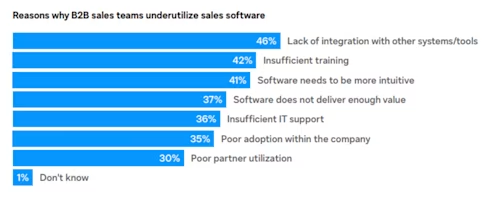
B2B Sales Trends: Customer Experience, Automation and the Impact of Technology
Learn how B2B sales teams have implemented new technology to address the complexity of generating, negotiating, signing, acting on and storing sales contracts.

B2B sales are essential to business growth, and that success is increasingly being driven by the online evolution. Industries are more widely embracing the benefits of the digital revolution following a period of vast workplace transformation.
With many B2B sellers now comfortably ensconced in permanent remote positions, they’re frequently adopting new technologies and making strategic moves to maintain a competitive advantage.
A research report from Docusign surveyed more than 750 sales professionals to examine the rapidly evolving state of selling processes and priorities. The data revealed key sales trends, including the growing use of technology to deliver better customer experiences, how successful sales teams adapted to remote selling and the need to digitize and automate the contract process.
Here’s a preview of some of the key findings:
The state of B2B sales
Adjusting to remote operations was difficult for B2B sales teams and it had a noticeable impact on their ability to hit targets. In years past, a significant majority of B2B sales teams exceeded their targets, but in 2020, only 20% did so.
The research found that sales operations, for example, is not only the most common collaborator for B2B sales teams, but also the most challenging group for sales to work with.
The relationship that B2B sales teams have with the legal department is complex as well—this is particularly problematic given that any large deal generally requires legal involvement, making effective collaboration absolutely essential.
Despite the tumult of the past few years and the challenges it magnified, sales teams continue to use revenue as their top KPI, though quota attainment and profitability were also considered important. Notably, sales teams don’t rely heavily on win rate as a key metric, even though it can be a proxy for sales effectiveness and competitive standing.

Evolving B2B sales priorities
While research found just 22% of companies were prepared to pivot during the onset of the COVID-19 pandemic, the situation has since changed vastly. Now, sales leaders have effectively begun modernizing processes with technology to adjust to the new remote selling environment. This shift coincides with a significant change in priorities, too.
Unlike in past surveys where customer experience and digital transformation ranked as very low priorities, this year’s research found that customer experience is king. It’s the top priority across companies around the world and 67% say it will become even more of a priority through 2025.
Priorities of B2B Sales teams over the next five years
Will become MORE of a priority | No change | Will become LESS of a priority | |
|---|---|---|---|
Digital transformation | 72% | 22% | 5% |
Improving the customer experience | 67% | 28% | 5% |
Improving quality and volume of leads | 66% | 28% | 5% |
Maximizing selling time | 66% | 29% | 6% |
Closing more deals | 65% | 27% | 7% |
Driven by these new priorities, sellers and buyers are getting more comfortable with remote sales. They’re also starting to see extra value in flexible selling workflows. McKinsey found that 75% of sales teams say remote engagement is at least as effective as traditional in-person sales, compared to only 54% early in the pandemic. This mindset is pivotal, since remote selling will only become more important for sales teams that want to continue to win.
Technology’s role in transformation
As B2B sales teams consider new technology investment, it’s critical to acknowledge that investment alone is not enough—success is determined by how technology is implemented and used. Docusign’s research shows that despite overwhelmingly self-identifying as “innovators,” respondents struggle to unlock the potential of their technologies—93% of B2B sales teams are not fully utilizing their tools. However, proper implementation of more intuitive solutions can overcome challenges such as poor integration, training and ease of use.

Looking more closely at the actual tools that sales teams use, CRM is the most common technology (used by 53% of sales teams), leaving significant room for growth. Teams also rely heavily on sales analytics tools and performance management technology. There is, however, opportunity for them to better leverage other technologies like quote management (CPQ), electronic signature and contract lifecycle management (CLM), especially as the volume and the complexity of deals grows.
The impact of technology on sales contracting
Within the sales process, one process that’s in dire need of a transformation at many companies is contracting. The volume of contracts that most teams deal with is significant—80% of sales teams execute over 500 contracts a month, according to Forrester research commissioned by Docusign. Docusign’s research shows that the value of B2B sales contracts is significant, too: 87% of contracts are over $10K in value, 44% are over $100K and 23% are over $1M. As this value grows, it becomes even more important for sales teams to execute flawlessly and provide a seamless, efficient customer experience.
Using automation, CLM platforms can alleviate the complexity of generating, negotiating, signing, acting on and storing sales contracts. Simply put, CLM delivers a more efficient end-to-end contract process, which results in a much better customer experience. Today, however, less than 10% of sales teams have fully automated any part of the sales contracting process—leaving room for sales teams to get an advantage.
Ultimately, the disruption caused by COVID-19 was a wake up call—change is always around the corner and organizations have to be ready. Docusign’s detailed research explores current trends, the role of technology and what leaders are changing based on future expectations. The insights should be relevant to any sales organization looking to adapt to an ever-changing future.
For more detailed data on the state of B2B sales, key trends and future expectations, download Docusign’s B2B Sales Trends Report.
Related posts
Docusign IAM is the agreement platform your business needs


